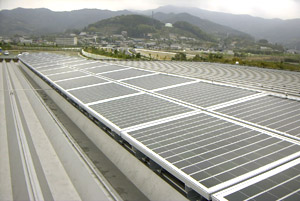April 11, 2002 -- Honda Engineering Co., Ltd., the production engineering subsidiary of Honda Motor Co., Ltd. based in Sayama, Saitama, has independently developed next generation thin film solar cells using primarily a non-silicon compound material. In a further breakthrough, the company has developed technology enabling mass production of the solar cells. Application of the non-silicon compound results in a lower cost than with materials conventionally used to
produce solar cells.
Solar cells using silicon have gained in popularity in recent years as a clean energy source. However, when the large amount of energy required to manufacture solar cells is taken into consideration, the silicon solar cell cannot be called completely ‘environmentally friendly.’ Further, manufacturing costs of silicon solar cells are high versus the amount of power generated.
In order to foster more widespread application of solar cells, it is necessary to achieve both further cost reduction and the higher efficiency of the photoelectric transfer process. Thin film solar cells using non-silicon materials have received attention as a new product with the potential to satisfy these concerns. However, non-silicon thin film solar cells have had the additional challenge of achieving performance uniformity on the surface of the cell.
Honda Engineering succeeded in independently developing the process technology to overcome these various challenges through the development of the next generation thin film solar cell.
| · | By using the thin film made from a compound of non-silicon materials (copper, indium, gallium, selenium (CIGS)), the energy consumed during the manufacturing process is reduced to a fraction of the cost for the conventional crystal silicon solar cell. |
| · | The highest level of photoelectric transfer efficiency for a thin film solar cell has been achieved (an increase of approximately 20 percent compared to the amorphous silicon solar cell), enabling a reduction in the power generation cost to a lower level than even the power rates of general households. |
As the first step in introducing the new solar cell, Honda Engineering will install it in Honda’s Hosoe Outboard Engine Plant in Hosoe Town, Shizuoka Prefecture in spring 2002 (accumulated amount of power generated annually: 100,000KWh). In the future, installation of this solar cell will be extended to other Honda production plants in Japan and overseas, with solar cells also to be sold to outside parties with large-scale needs.
< Comparison of major solar cell types >
| Type | Crystal silicon |
Amorphous silicon |
CIGS compound |
| Manufacturing energy |
× | ◎ | ◎ |
| Power generating cost |
△ | △ | ◎ |
| Transfer efficiency |
◎ | △ | ○ |
| Reliability | ◎ | △ | ◎ |

<Thin film solar cell panels on roof of Hosoe Plant>